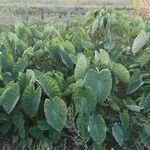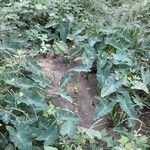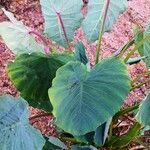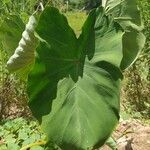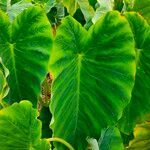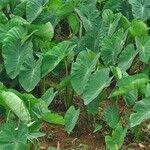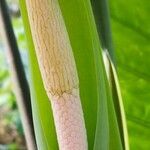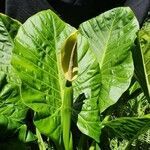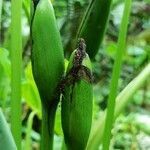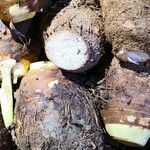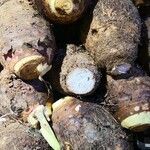Corms underground, starchy; stolons elongate, with nodes produced at or near surface, spreading horizontally. Leaves: petiole green, often purple apically, 30--80(--180) cm, spongy and filled with air spaces; blade green to dark green or glaucous blue-green on adaxial surface, usually with red or purple spot at point of petiole attachment, peltate for 2.5--7 cm, 17--70 ´ 10--40 cm; primary lateral veins parallel, secondary lateral veins netted, forming collective vein between primary lateral veins; apex mucronate. Inflorescences: spathe 20--35 cm; tube green; blade orange outside and in, opening basally and reflexing apically at anthesis to expose spadix, more than 3 times longer than tube; spadix 9--15 cm. Flowers: pistillate flowers pea green, interspersed with white pistillodes; ovaries 1-locular; ovules 36--67; sterile flowers white to pale yellow; staminate flowers and sterile tip pale orange, stamens 3--6, connate. Fruits orange. Seeds 1--1.5 mm, not observed in flora area. 2n = 28, 42 (Old World).
This plant has large flat leaves on the end of upright leaf stalks. It grows up to 1 m high. The leaf stalk or petiole joins the leaf towards the centre of the leaf. The leaves are 20-50 cm long. Near the ground a thickened rounded corm is produced. Around this plant their is normally a ring of small plants called suckers. Many different varieties occur. If left to maturity, a lily type flower is produced in the centre of the plant. It has a spathe 15-30 cm long which is rolled inwards. The flowers are yellow and fused along the stalk. There are many named cultivated varieties. Taro comes in two basic forms. The Dasheen type Colocasia esculenta var. esculenta and Colocasia esculenta var. antiquorum or the Eddoe type. The basic difference is the adaptation of the Eddoe type to storage and survival in seasonally dry places, while the dasheen type needs to be maintained in a more or less continuously growing vegetative stage. These are now recognised as separate species names.
Moderately robust, stoloniferous, colony-forming herb with creeping rhizome (cultivars often massively rhizomatous, sometimes cormeliferous and not stoloniferous). Leaves few to several together; petiole to c. 1 m long, sheathing in lower ⅓–½; blade peltate, broadly ovatosagittate, ± pendent, c. 30–60 (–80) cm long, glaucous (except some cultivars). Inflorescences (2–) c. 5 together, highly fragrant; spathe tube narrowly ovoid, c. 3 cm long; limb somewhat deflexed, narrowly lanceolate, to c. 15 cm long, golden yellow; spadix subsessile, considerably shorter than spathe; female zone slightly shorter than lower spathe, with numerous small green pistils sporadically interspersed with white staminodia; appendix slender, slightly longer than male zone to reduced and almost absent.
Robust, acaulescent herb to 2 m. high or more; stem a swollen starchy tuber.. Leaf broadly ovate in outline, peltate, cordate-sagittate, held pendent from ± erect petiole, apex obtuse, basal lobes ± rounded, primary lateral veins 6–10, prominent on lower surface, distal side veinlets of primary lateral veins arching towards margin and forming regular, parallel series.. Flowering is very rare in some cultivars.. Spathe 20–30 cm. long, basal tube green, short, apical blade yellow to orange, much longer.. Spadix shorter than spathe with conic, sterile appendix up to 4 cm. long (occasionally reduced or absent).. Flowers unisexual, lacking tepals.
Robust, tuberous, acaulescent perennials 1-2 m high, with a cluster of long-petioled leaves. Leaves large; laminae peltate, ovate-cordate, 20-50 cm long, acute to acuminate, entire, sometimes white-mottled, veins somewhat reddish; petiole ± > lamina, light to dark green, reddish-or purple-tinged. Scape stout, < petiole. Spathe pale yellowish, ± 20 cm long, rolled inwards at apex. Spadix ± ⅔ of spathe; basal female zone separated from upper male zone by shorter sterile zone made narrower by constriction of spathe; terminal sterile appendage variable in length with much-narrowed, acute tip. Berries green.
Cultivated extensively in our area for the tuber (coco-yam) and frequently naturalized
The large leaves are seldom accompanied by flowers.
